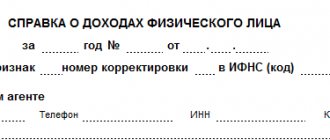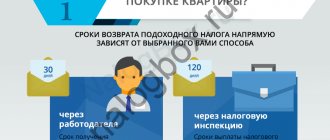Standard tax deductions are provided to certain categories of individuals. Their size for each category is fixed (clauses 1 - 4, Article 218 of the Tax Code of the Russian Federation). What is the standard deduction available to employees in 2013-2014? Who is entitled to the standard deduction and what is the procedure for issuing them? We provide examples of calculations of standard tax deductions in 2013 - 2014. Unlike other tax deductions, standard tax deductions are not conditional on the presence of any expenses by an individual. They can be used monthly . In other words, income received at the end of each month of the tax period can be reduced by standard deductions due to the taxpayer. Read: How to fill out the Declaration program in Form 3 Personal Income Tax yourself? The only criterion determining the possibility of applying this type of tax deduction is the classification of the taxpayer into the appropriate category of persons to whom these deductions are provided.
Who is eligible for the child tax credit?
By law, if you have children under the age of eighteen, children with disabilities, or children receiving full-time education at any educational institution (under the age of 24), you are entitled to a standard tax deduction. In addition, the monthly tax deduction applies not only to parents, but also to the child’s guardians, trustees, adoptive parents, as well as their spouses who support the children.
Both parents at work and one parent, who in this case can claim a double deduction, can receive a monthly tax deduction. But in order to receive the double standard child tax credit in 2013 at the place of work of one of the parents, the other parent must refuse the deduction by writing a corresponding application.
Reporting and tax register
Form 2-NDFL . In the certificate on Form 2-NDFL, the accountant will reflect all deductions provided to the employee for the past year. Even if the employee delayed the application and brought it in at the end of the year, the certificate must indicate the deductions due to him.
Tax card . Accountants keep records of income paid to employees, tax deductions provided to them, as well as the amounts of personal income tax withheld in independently developed tax accounting registers. This rule is established in paragraph 1 of Article 230 of the Tax Code of the Russian Federation. Operations for calculating and withholding tax in this register are reflected in tables corresponding to the applicable personal income tax rate. Canceling entries must also be reflected there. In practice, they are called “tax reversals.”
Standard child tax credit in 2013: how much was it raised to?
In 2012, there was an increase in the child tax deduction and today the amount of the deduction depends on the code and on whether it is the first, second, third or disabled child.
So, for example, the deduction for the first child under code 114 will be 1,400 rubles, for the second – under code 115 – 1,400 rubles, for the third under code 116 – 3,000 rubles, for a disabled child under code 117 – 3,000 rubles.
Currently, the amount within which a child tax deduction is made is 280,000 rubles. This means that the deduction is made until the income of the child’s parent in a particular calendar year reaches this amount.
Will the spouse to whom the 0% deduction is allocated be able to receive a property deduction in the future?
When purchasing housing in joint ownership, spouses have the opportunity to distribute the deduction entirely to one of the spouses (in the proportions of 0%/100%).
Then, for housing purchased before 2014, the natural question will be: will the spouse to whom the 0% deduction was distributed receive a property deduction in the future? Or will he be considered to have also “used” his deduction?
Letters from the Federal Tax Service of Russia dated January 15, 2013 N ED-3-3/ [email protected] and dated November 23, 2012 N ED-3-3/ [email protected] indicate that the taxpayer who declared a 0% deduction and did not personally contact the inspectorate for receiving a deduction, in the future, when purchasing (constructing) housing, you may receive a property deduction under paragraphs. 2 p. 1 art. 220 Tax Code of the Russian Federation . Accordingly, the spouse who did not take advantage of the deduction will be able to receive it in the future.
Example: In 2009, the spouses Stepashin N.P. and Stepashina Zh.E. bought an apartment worth 2 million rubles and registered it as joint ownership. The couple decided that the husband would receive the entire deduction for the apartment. In this regard, they distributed the deduction in shares of 100% - Stepashin N.P. and 0% - Stepashina Zh.E.
In 2012, the couple sold the purchased apartment and bought a new one for 3 million rubles, which was registered entirely in the name of the spouse. Since the spouse is not considered to have taken advantage of the previous deduction (with a 0% share), she has the right to receive the entire deduction for the new apartment.
As a result, Stepashin N.P. received a deduction of 2 million rubles (returned 260 thousand rubles) for the first apartment purchased and Stepashina Zh.E. received a 2 million ruble deduction (returned 260 thousand rubles in tax) for the second apartment.
How to get the standard child deduction?
To receive a standard tax deduction for a child in 2013, documents confirming the right to deduction, age and status of the child must be provided to the employer. What documents exactly are we talking about? This:
- application of the established form for the provision of a tax deduction;
- certificate 2-NDFL for the current year;
- a copy of the child's birth certificate;
- a certificate from the child’s place of study (if the children are between 18 and 24 years old and are studying in various educational institutions);
- certificate of disability for disabled children of the first and second groups.
Sometimes there are situations when the employer, for some reason, does not provide tax deductions to employees. In this case, the employee can receive the deduction due to him next year. To do this, he must contact the tax authority with the same documents, and also provide his tax return for the previous year in form 3-NDFL.
How to recalculate
The standard tax deduction for a child is provided for each month of the calendar year (subclause 4, clause 1, article 218 of the Tax Code of the Russian Federation). Consequently, the accountant should again calculate the personal income tax for each month of the current year (clause 3 of Article 226 of the Tax Code of the Russian Federation). When recalculating, you need to keep in mind that personal income tax at a rate of 13% is determined on an accrual basis from the beginning of the year, taking into account the amount of tax withheld in previous months of the current tax period (clause 3 of Article 226 of the Tax Code of the Russian Federation).
Table 1 Amount of deduction per child
| The amount of the deduction | Child |
| 1400 rub. | First |
| 1400 rub. | Second |
| 3000 rub. | Third and every subsequent |
| 3000 rub. | A disabled child under the age of 18 or a full-time student, graduate student, resident, intern, student under the age of 24, if he is a disabled person of group I or II |
The employee has been working for the company for several years.
Using a numerical example, we will consider how to recalculate personal income tax if an application for deduction was submitted late by an employee who has been working in the organization for several years.
Example 1. Painter V.S. Petrov has been working at All Colors of the World CJSC since 2008. In January 2013, his son was born. The employee submitted an application for the deduction in October 2013. For the period from January to September 2013, he received a salary of 20,000 rubles. per month. Personal income tax is withheld from this amount without taking into account a deduction for a child in the amount of 23,400 rubles. (RUB 20,000 × 9 months × 13%). How to recalculate personal income tax for the period from January to September 2013? Solution Before making the recalculation, the accountant determined that the employee was entitled to a deduction for a child in the amount of 1,400 rubles. The deduction can be applied to income received for the period from January to September 2013, since the total amount of income during this time was 180,000 rubles. (20,000 rubles × 9 months), that is, did not exceed 280,000 rubles. The accountant will recalculate personal income tax for each month separately, starting from the month of the child’s birth, that is, from January 2013. As a result of the calculations, the amount of personal income tax for the period from January to September 2013 will not be 23,400 rubles, but 21,762 rubles. [(RUB 20,000 × 9 months – RUB 1,400 × 9 months) × 13%]. The overpayment of personal income tax for the period from January to September 2013 amounted to 1,638 rubles. (RUB 23,400 – RUB 21,762).
The above procedure for recalculating personal income tax is also suitable for the case where a late application was submitted by an employee who has been working since January of the current year.
The employee has not been working for the company since the beginning of the year
If an employee has joined an organization not since January of the current year, then to receive a deduction he must submit a certificate in Form 2-NDFL from his previous place of work (clause 3 of Article 218 of the Tax Code of the Russian Federation). The accountant needs the certificate to determine whether the amount of income that allows for a deduction is exceeded.
Please note: a new employer can provide an employee with standard tax deductions only for income accrued in this company from the date of employment. With regard to income received in the current calendar year, but from another (other) employer, the new employer does not have the right to recalculate. This is stated in letters of the Ministry of Finance of Russia dated 02/27/2013 No. 03-04-05/8-154 and dated 04/07/2011 No. 03-04-06/10-81.
Example 2. In April 2013, P.A. got a job at CJSC “Bulochka” as a baker. Myagkov. On the day of employment, he presented a certificate in form 2-NDFL from his previous place of work for the period from January to March 2013. It indicated the amount of income subject to personal income tax at a rate of 13% - 90,000 rubles. Salary of P.A. Myagkova at CJSC “Bulochka” - 35,000 rubles. per month. During the period from April to September 2013, the employee earned 210,000 rubles. (RUB 35,000 × 6 months). The accountant withheld personal income tax from this amount - 27,300 rubles. (RUB 210,000 × 13%). In October 2013, P.A. Myagkov brought an application for deduction to the accounting department for his eight-year-old daughter. How can an accountant at ZAO Bulochka recalculate personal income tax? Solution Before making the recalculation, the accountant determined that the employee was entitled to a deduction for a child in the amount of 1,400 rubles. The total amount of income for the period from January to September is 300,000 rubles. (90,000 rubles + 35,000 rubles × 6 months), that is, exceeds 280,000 rubles. The procedure for applying a standard tax deduction by an accountant at ZAO “Bulochka” is shown in table. 2. In connection with the application of the child deduction, the amount of personal income tax for the period from April to September 2013 should be 26,390 rubles. The overpayment of personal income tax for this period is equal to 910 rubles. (RUB 27,300 – RUB 26,390). When calculating the amount of tax for October by the amount of overpayment, you need to reduce personal income tax, which is subject to deduction from income and transfer to the budget.
In some months the employee had no income
There are cases when in the current year an employee had no income in some months. Although before that I worked in this company for more than one year. For example, a woman was on maternity leave.
Table 2 Recalculation of the standard tax deduction in connection with the employee’s filing of an application
| Months of 2013 | Amount of taxable income | Personal income tax withheld without applying a deduction for the child | Providing the standard child tax credit | Personal income tax subject to withholding using a child deduction | |
| per month | cumulative total since the beginning of the year | ||||
| January | 30 000 | 30 000 | × | × | × |
| February | 30 000 | 60 000 | × | × | × |
| March | 30 000 | 90 000 | × | × | × |
| April | 35 000 | 125 000 | 4550 | 1400 | 4368 |
| May | 35 000 | 160 000 | 4550 | 1400 | 4368 |
| June | 35 000 | 195 000 | 4550 | 1400 | 4368 |
| July | 35 000 | 230 000 | 4550 | 1400 | 4368 |
| August | 35 000 | 265 000 | 4550 | 1400 | 4368 |
| September | 35 000 | 300 000 | 4550 | 0 | 4550 |
| Total | 300 000 | 300 000 | 27 300 | 7000 | 26 390 |
For months in which there was no income, you must provide a deduction. The deduction is summed up, and the employee will be able to receive it when, again in this tax period, he receives income subject to personal income tax at a rate of 13%. This follows from the letter of the Ministry of Finance of Russia dated July 23, 2012 No. 03-04-06/8-207.
Example 3. Seamstress JSC “Masteritsa” I.A. Igolkina gave birth to a son in January 2013. In October 2013, she returned to work part-time. In the period from January to September 2013, from payments subject to personal income tax, she received an annual bonus of 10,000 rubles. The bonus was accrued and paid in February 2013. At the time the bonus was calculated, the employee did not submit an application requesting a deduction for her newborn child, so the accountant calculated the personal income tax without taking into account the deduction. The tax amount was 1300 rubles. (RUB 10,000 × 13%). In October 2013, I.A. Igolkina brought an application to the accounting department for a deduction for the child. How to calculate personal income tax from a salary for October 2013, if its amount was 8,000 rubles? Solution Let's solve the example in two stages. First, we will determine for what period the employee can be given a deduction, then we will calculate the amount of personal income tax. The period for providing the deduction and its monthly amount Before making the recalculation, the accountant determined that the employee was entitled to a deduction for a child in the amount of 1,400 rubles. The deduction can be applied to income received for the period from January to September 2013, since the total amount of income during this time was 10,000 rubles, that is, did not exceed 280,000 rubles. The employee is entitled to a deduction for each month starting from the month of birth of the child, that is, from January 2013. Calculation of personal income tax from wages for October 2013 When calculating personal income tax from wages for October, the accountant needs to apply a deduction for 10 months - for the period from January to October 2013. In October, the employee earned 8,000 rubles. Consequently, her total income for the period from January to October 2013 is equal to 18,000 rubles. (RUB 10,000 + RUB 8,000). The total amount of deduction for this period is 14,000 rubles. (1400 rubles × 10 months). The total amount of personal income tax for the period from January to October is 520 rubles. [(RUB 18,000 – RUB 14,000) × 13%]. Personal income tax for October is calculated as the difference between the amount of personal income tax withheld earlier and the amount of personal income tax for the period from January to October 2013. This follows from paragraph 3 of Article 226 of the Tax Code of the Russian Federation. In February (for the period from January to February), the withheld amount of personal income tax was 1,300 rubles. And in October (for the period from January to October) personal income tax in connection with the use of the deduction is 520 rubles. That is, there was an overpayment of tax in the amount of 780 rubles. (1300 rub. – 520 rub.).
Please note that if income payments are completely stopped and are not resumed before the end of the year, no deduction can be provided for those months. This is stated in the letter of the Ministry of Finance of Russia dated 05/06/2013 No. 03-04-06/15669.
Financial department specialists considered the following situation. A company employee worked and received a salary from January to October. When calculating personal income tax, she was given a deduction for her first child. In November, she went on her second maternity leave. And therefore, from November until the end of the year, she did not receive income subject to personal income tax. In accordance with the logic given in the letter, she is not entitled to a deduction for her first child in November and December.
Double tax deduction: documents and rules for provision
If one parent refuses a tax deduction in favor of the other parent, then the second has the right to a double tax deduction. The refusal of the deduction is formalized by a corresponding application, which, together with the application for a double tax deduction, the employee who wishes to receive it must submit to his employer.
In addition, you will have to provide the employer providing the tax deduction with a monthly 2-NDFL certificate from the place of work of the parent who refused the deduction (since otherwise it is impossible to determine when the salary of the other parent will reach the limit of 280,000 rubles established for the child tax deduction), and also documents confirming the child’s status - birth certificate, certificate from the place of study, certificate of disability (for disabled children).
Also, the only parent of the child (single mother, widows, widowers, adoptive parents, etc.) has the right to double deduction. But when entering into a remarriage or when a child is adopted by another person, the parent ceases to be considered the only one.
But we should not forget that only those taxpayers who support a child and those who have official income taxed at a rate of 13% (for personal taxes) have the right to a tax deduction.
Therefore, if one of the child’s parents does not work and, accordingly, does not have income that is taxed at a rate of 13%, he cannot legally transfer his right to a tax deduction to a working parent.
What to do with overpayment of personal income tax
Excessively withheld personal income tax can be offset against future tax payments or returned (clauses 1 and 14 of article 78, clause 1 of article 231 of the Tax Code of the Russian Federation).
Test . While the calendar year is not over, the overpayment can be offset against future payments. That is, take into account when calculating the salary tax for November and December. Is an employee’s application required to offset the overpayment? Personal income tax at a rate of 13% is determined on an accrual basis from the beginning of the year with the offset of the amount of tax withheld in previous months of the current tax period (clause 3 of Article 226 of the Tax Code of the Russian Federation). Therefore, the employee’s application for personal income tax credit is not required.
Return . The excess amount of personal income tax withheld can be returned. The procedure for returning personal income tax is established in Article 231 of the Tax Code. The employee should write an application in which he will indicate the details of his bank account (bank card).
Future changes to the child deduction amount
The issue of increasing the tax deduction for children in 2013 is currently being discussed. So in the near future, the amount of deduction for the first child may be 1,400 rubles, for the second – 2,000 rubles, for the third, fourth, and so on – 4,000 rubles. For disabled children under 18 years of age, as well as for full-time students, interns, graduate students, and residents under 24 years of age who are disabled in the first or second group - 12,000 rubles. And the amount within which tax deductions for children are made will be raised from 280,000 to 350,000 rubles
How to calculate the child tax deduction in 2013?
Calculating the child tax deduction is quite simple, since the amount of the deduction depends on the number of children and is fixed. To make a deduction, the deduction rate of a specific employee is taken and subtracted from the amount of accrued wages, and income tax is already taken from the remainder. Thus, the tax base is reduced by the amount of the deduction.
For example, the accrued salary is 30,000 rubles. If the employee has a third child, the deduction is 3,000 rubles. This means that out of 30,000 - 3,000 = 27,000, then we take an income tax of 13% from this amount - 3,510 rubles, and the employee receives 30,000 - 3,510 = 26,490 rubles.
Child tax deduction in 2013: single mothers
Today, single mothers in our country have the right to a double tax deduction for the costs of maintaining each of their children until they reach the age of 18, as well as for children under 24 years of age who are students, cadets, graduate students, and residents.
To receive a double tax deduction, a single mother must provide documents confirming that the child has only one parent. This may be a birth certificate, where only one parent is indicated - the mother, a certificate of form 25 from the registry office, which will confirm that the child’s father is entered on the birth certificate according to the mother’s words (if both parents are recorded on the certificate), a death certificate of the father a child entered on the birth certificate, a court decision declaring the child’s father dead or missing.
Many people are interested in the question: is it possible to receive a double deduction for the child of the mother with whom the child lives if the parents of this child have divorced their marriage or are not married at all? If the father who recognized the child and is now alive is included in the birth certificate, then the mother is not considered a single parent or the only parent of the child. So she can receive a double deduction only if the child’s father refuses the deduction in her favor.










